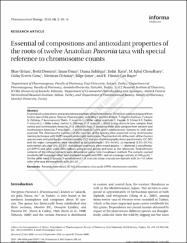| dc.contributor.author | Orhan, İlkay Erdoğan | |
| dc.contributor.author | Demirci, Betül | |
| dc.contributor.author | Omar, Iman | |
| dc.contributor.author | Siddiqui, Huma | |
| dc.contributor.author | Kaya, Erdal | |
| dc.contributor.author | Choudhary, M. Iqbal | |
| dc.contributor.author | Başer, K. Hüsnü Can | |
| dc.date.accessioned | 2019-10-19T14:03:33Z | |
| dc.date.available | 2019-10-19T14:03:33Z | |
| dc.date.issued | 2010 | |
| dc.identifier.issn | 1388-0209 | |
| dc.identifier.uri | https://dx.doi.org/10.3109/13880200903029332 | |
| dc.identifier.uri | https://hdl.handle.net/11421/12624 | |
| dc.description | WOS: 000273992300002 | en_US |
| dc.description | PubMed ID: 20645750 | en_US |
| dc.description.abstract | Essential oil compositions and antioxidant potentials of fourteen ethanol (75%) root extracts prepared from twelve taxa of the genus Paeonia (Paeoniaceae), including P. arietina Anders., P. daurica Andrews, P. x kayae N. Ozhatay, P. kesrouanensis Thieb., P. mascula (L.) Miller subsp. arasicola G. Kaynak,. Yilmaz & R. Daskin, P. mascula (L.) Miller subsp. bodurii N. Ozhatay, P. cf. mascula L. (Mill.) subsp. mascula (two samples from central and northeastern Anatolia), P. cf. officinalis Retz., P. peregrina Miller (two samples from western and northwestern Anatolia), P. tenuifolia L., P. turcica Davis & Cullen, and P. wittmanniana Hartwiss ex Lindl. were assessed. The chromosome numbers of the root tips of the species were examined using chromosome staining technique with Shiff's reagent under Leitz microscope. The essential oils of the roots of the Paeonia species were analyzed by gas chromatography (GC) and gas chromatography-mass-spectrometry (GC-MS) and the major components were identified as salicylaldehyde (10%-94.4%), cis-myrtanal (5.5%-59.7%), and methyl salicylate (2%-52.2%). Antioxidant potentials were tested against 1,1-diphenyl-2-picrylhydrazyl (DPPH) and nitric oxide (NO) radicals using propyl gallate and rutin as the references. Total phenolic contents of the ethanol extracts were determined using Folin-Ciocalteau's method. The extracts exerted moderate NO scavenger effect and displayed insignificant DPPH radical scavenger activity at 500 mu g mL(-1). On the other hand, P. daurica, P. tenuifolia and P. cf. mascula subsp. mascula are diploids with 2n = 10, while other nine taxa are tetraploids with 2n = 20. | en_US |
| dc.language.iso | eng | en_US |
| dc.publisher | Taylor & Francis Inc | en_US |
| dc.relation.isversionof | 10.3109/13880200903029332 | en_US |
| dc.rights | info:eu-repo/semantics/openAccess | en_US |
| dc.subject | Paeonia | en_US |
| dc.subject | Essential Oil | en_US |
| dc.subject | Gc-Ms | en_US |
| dc.subject | Antioxidant | en_US |
| dc.subject | Nitric Oxide | en_US |
| dc.subject | Dpph | en_US |
| dc.subject | Chromosome Numbers | en_US |
| dc.title | Essential oil compositions and antioxidant properties of the roots of twelve Anatolian Paeonia taxa with special reference to chromosome counts | en_US |
| dc.type | article | en_US |
| dc.relation.journal | Pharmaceutical Biology | en_US |
| dc.contributor.department | Anadolu Üniversitesi, Eczacılık Fakültesi, Farmakognozi Anabilim Dalı | en_US |
| dc.identifier.volume | 48 | en_US |
| dc.identifier.issue | 1 | en_US |
| dc.identifier.startpage | 10 | en_US |
| dc.identifier.endpage | 16 | en_US |
| dc.relation.publicationcategory | Makale - Uluslararası Hakemli Dergi - Kurum Öğretim Elemanı | en_US |
| dc.contributor.institutionauthor | Demirci, Betül | |
| dc.contributor.institutionauthor | Başer, K. Hüsnü Can | |


















